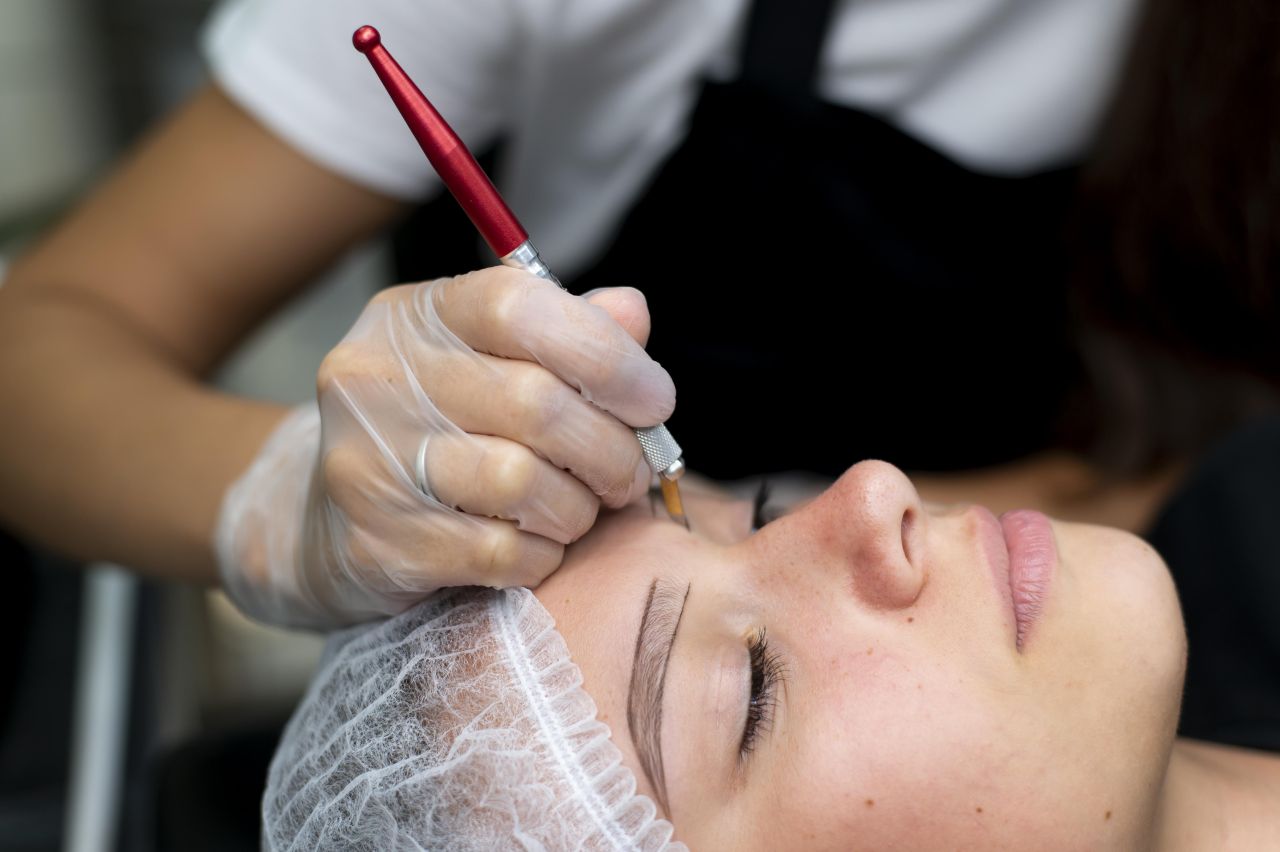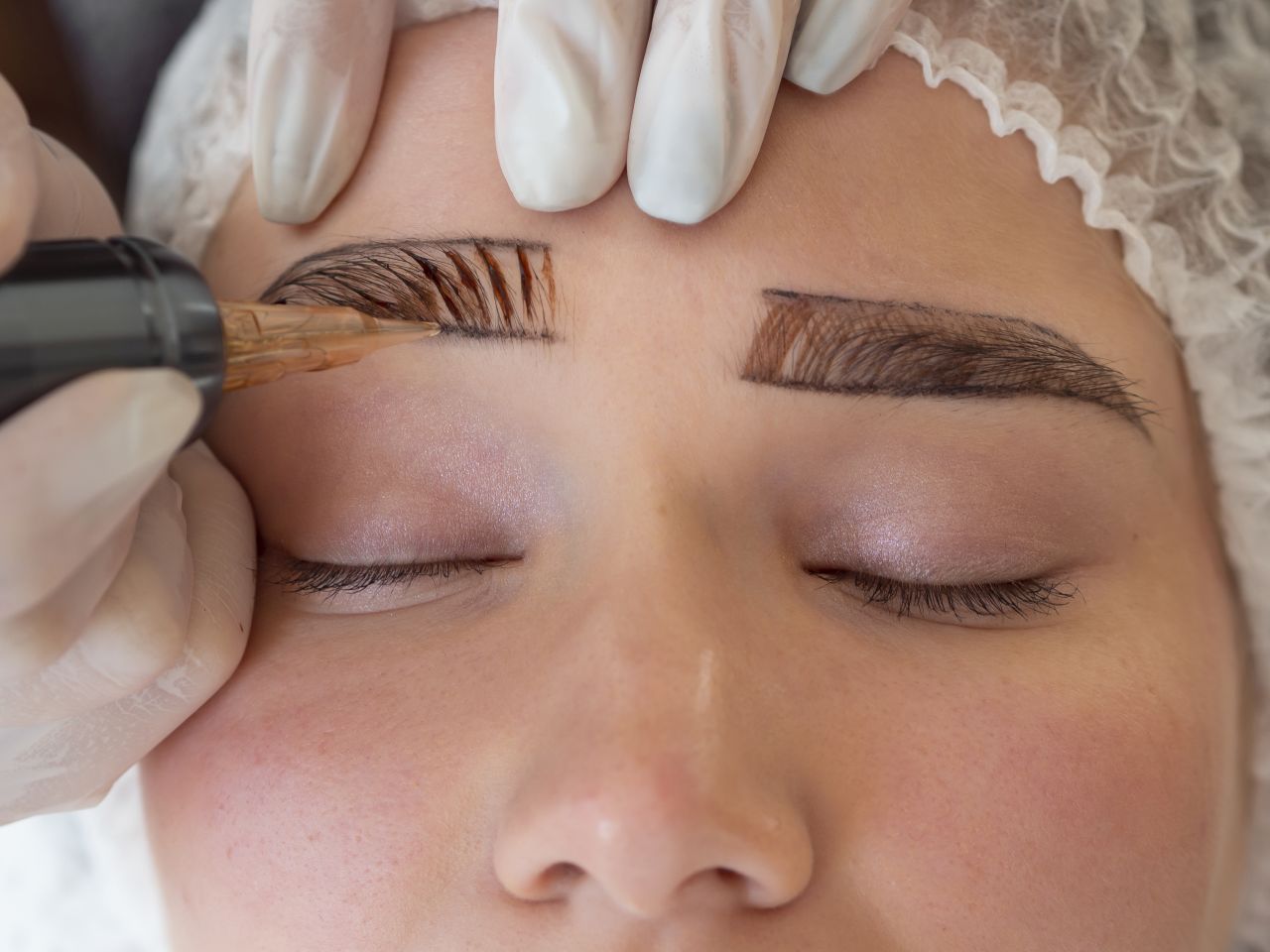Eyebrow microblading has become a highly sought-after procedure for creating defined and natural-looking eyebrows in the beauty industry. Unlike traditional eyebrow tattoos, microblading offers semi-permanent results, meaning that pigment fades and touch-ups are needed over time.
This intentional semi-permanence provides several advantages for those seeking to enhance their eyebrows without a permanent commitment.
Let’s get straight to the point.
Eyebrow microblading is a semi-permanent cosmetic procedure that uses a handheld tool to create hair-like strokes with pigment on the skin’s outer layer. It lasts 1-3 years due to shallow pigment placement, skin regeneration, and environmental influences.
The semi-permanent nature allows for flexibility in brow style and natural fading. Proper aftercare, sun protection, and regular touch-ups help prolong results, providing a natural and adaptable enhancement to your eyebrows without the permanence of traditional tattoos.
Why Microblading Is Semi-Permanent?
Microblading results are classified as semi-permanent due to several factors contributing to the gradual fading of the pigment over time.
1. Depth Of Pigment Placement
The primary reason for the semi-permanent nature of microblading lies in how the pigment is placed in the skin. Traditional tattoos deposit ink deep into the dermis, the thick layer of skin beneath the epidermis, which results in permanent colouring.
Microblading, however, targets the epidermis—the skin’s outermost layer. Since the pigment is placed more superficially, it naturally fades over time as the skin regenerates.
2. Type Of Pigment Used
Microblading pigments are specifically formulated to fade over time. These pigments are designed to break down naturally in the body, allowing for gradual fading rather than the sharp lines and permanent colouring often associated with traditional tattoos.
This fading process ensures that the brows age naturally and mimic the look of real hair.
3. Skin Cell Turnover
Our skin undergoes constant renewal, shedding and replacing old cells with new ones. As this happens, the pigment moves closer to the skin’s surface and eventually fades.
Factors like skin type, metabolism, and age influence skin turnover rate, meaning the longevity of microblading can vary from person to person.
Microblading Process Overview
- Consultation and Design: The first step in microblading is consulting with a trained technician. During this consultation, the technician assesses the client’s facial features, skin tone, and desired eyebrow shape. This personalised plan ensures that the final result meets the client’s expectations, including the brows’s shape, colour, and thickness.
- Preparation of the Skin: The technician begins by cleaning the eyebrow area and applying a topical numbing cream to reduce discomfort during the procedure. The skin is then mapped and measured to ensure symmetry and accuracy in the final design.
- Creating Hair-Like Strokes: Using a handheld microblade, the technician makes shallow, fine incisions in the skin that resemble natural eyebrow hairs. The pigment is deposited into each stroke, customising the angle, depth, and density to create the desired look.
- Pigment Application: Pigments specifically designed for microblading are chosen to match the client’s natural eyebrow colour. These pigments are applied in layers, gradually building up colour intensity. The technician works carefully to ensure the final result is natural and well-balanced.
- Final Adjustments and Aftercare: Once the microblading process is complete, the technician evaluates the brows to make final adjustments for symmetry. After the procedure, clients receive detailed aftercare instructions, including how to clean and moisturise the brows to aid healing and pigment retention.
How Long Do Microblading Results Last?
While microblading results vary depending on skin type, aftercare, and lifestyle factors, most people can expect their results to last between one and three years. Regular touch-ups will help prolong the appearance of your brows.
Factors That Influence Microblading Longevity
1. Skin Type
Individuals with oily skin tend to experience faster fading, as the excess oil breaks down the pigment more quickly. Conversely, those with dry or normal skin may retain the pigment longer.
2. Sun Exposure
Sun exposure accelerates pigment breakdown. Ultraviolet (UV) rays from the sun can cause the pigment to fade prematurely, especially without proper protection.
3. Lifestyle Choices
Certain lifestyle choices can also affect the longevity of microblading results. For example, frequent swimming in chlorinated pools, using harsh skincare products, or smoking can all contribute to faster pigment fading.
4. Aftercare Practices
Following the recommended aftercare instructions is essential for maintaining microblading results. Neglecting these practices can lead to premature fading or uneven results.
5. Quality Of Pigments
The quality of the pigments used during the procedure determines how long the results last. High-quality pigments are more likely to retain their colour and fade naturally over time.
Benefits Of Microblading’s Semi-Permanent Nature
The semi-permanent nature of microblading offers several advantages for those considering this cosmetic procedure.
1. Flexibility In Aesthetic Choices
Because the pigment fades over time, microblading allows clients to change their brows’s shape, colour, and style as trends evolve or personal preferences shift. Unlike permanent tattoos, microblading offers flexibility without the need for painful removal processes.
2. Natural-Looking Results
One of the main goals of microblading is to achieve natural-looking eyebrows. By depositing pigment into the outer layer of skin, the results look more like natural hair rather than a solid, permanent tattoo.
Gradually fading also contributes to a softer, more natural appearance.
3. Adaptability With Age
As individuals age, their facial features and skin tone change. The semi-permanent nature of microblading ensures that eyebrows can adapt to these changes, allowing them to age gracefully alongside the client’s evolving appearance.
Is Semi-Permanence Intentional?
Yes, the semi-permanent nature of microblading is intentional. This temporary result allows clients to enjoy flexibility in their aesthetic choices and ensures that the brows look natural and age gracefully.
It also allows for adjustments as personal preferences and eyebrow trends change.
Conclusion
Eyebrow microblading is a popular cosmetic procedure that provides semi-permanent results. It allows for natural-looking, fuller eyebrows without requiring daily makeup application.
Several factors, including the depth of pigment placement, type of pigment, and skin cell turnover, contribute to the semi-permanent nature of microblading. While the results fade over time, clients can adjust their brows as needed.
Clients can enjoy beautiful, well-defined brows for years by following proper aftercare and scheduling regular touch-ups.
FAQs About Microblading
What Is Microblading?
Microblading is a semi-permanent cosmetic procedure that enhances eyebrow appearance by depositing pigment into the skin to create hair-like strokes, resulting in fuller and more defined brows.
How Long Does Microblading Last?
Microblading results typically last between 1 to 3 years, depending on factors like skin type, lifestyle, and aftercare practices.
Does Microblading Hurt?
Discomfort during microblading is minimal for most individuals and can be managed with topical numbing creams applied before the procedure.
Can Anyone Undergo Microblading?
While microblading is suitable for many people, individuals with certain skin conditions or those who are pregnant or breastfeeding may not be eligible. It’s essential to consult with a qualified technician to determine suitability.
How Do I Maintain My Microbladed Eyebrows?
Proper aftercare, including avoiding excessive sun exposure and following the technician’s instructions, is crucial for prolonging the longevity of microblading results. Additionally, touch-up appointments every 1 to 2 years help maintain eyebrow shape and colour.



